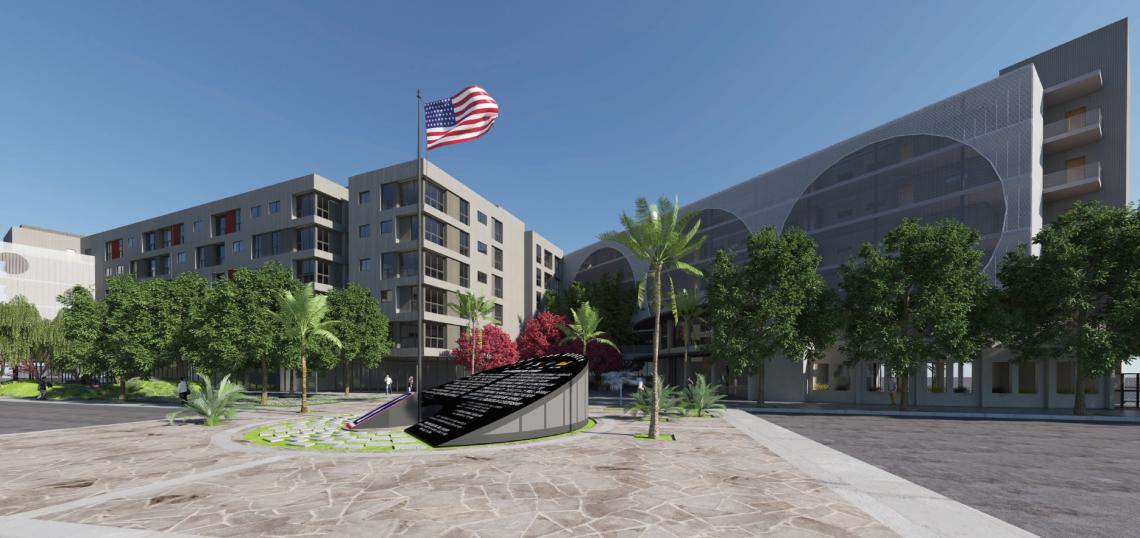In the mid-20th century, the expansion of the Los Angeles civic center often came at the expense of neighboring Little Tokyo, which famously saw residents, businesses, and religious institutions displaced to make way for Parker Center. But more than six decades after eminent domain decimated the neighborhood's historic footprint, a community-driven effort is taking steps to reclaim some of what was lost.
In 2018, local non-profit organizations Little Tokyo Service Center (LTSC) and Go For Broke announced a partnership to redevelop an LADOT parking lot next to the Geffen Contemporary with affordable housing and an education center focused on Japanese-American World War II veterans. The proposed First Street North development is now poised to roughly triple in size due to a move made earlier this year by Los Angeles City Councilmember Kevin de Leon.
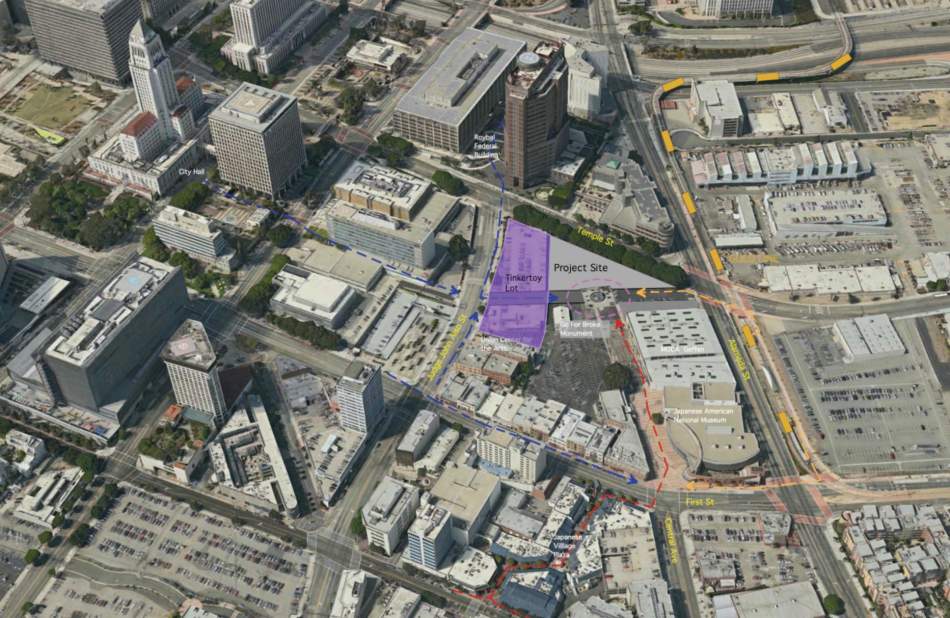 The First Street North and tinker toy garage sitesLittle Tokyo Service Center
The First Street North and tinker toy garage sitesLittle Tokyo Service Center
De Leon, a former state legislator who is rumored to be considering a run for mayor, introduced a motion in March which calls for expanding LTSC and Go For Broke's ground lease to incorporate an adjoining property at the intersection of Temple and Judge John Aiso Streets. That 1.5-acre site, currently vacant, was occupied by an LAPD parking structure until last year.
"Due to the irregular shape of the existing lease area, the amount of permanent supportive and affordable housing units that can be produced on site is significantly less than could be produced on a larger shaped site," reads de Leon's motion, which was adopted by the Council on March 23.
With more real estate to work with, LTSC will now be able to nearly triple the number of homes from the original 77-unit plan for First Street North, says Debbie Chen, the organization's director of real estate development. The project is now slated to include 228 studio, one-, two-, and three-bedroom apartments - all of which would be income restricted. Additionally, the developer hopes to set aside approximately 50 percent of the project as permanent supportive housing, potentially targeting homeless veterans.
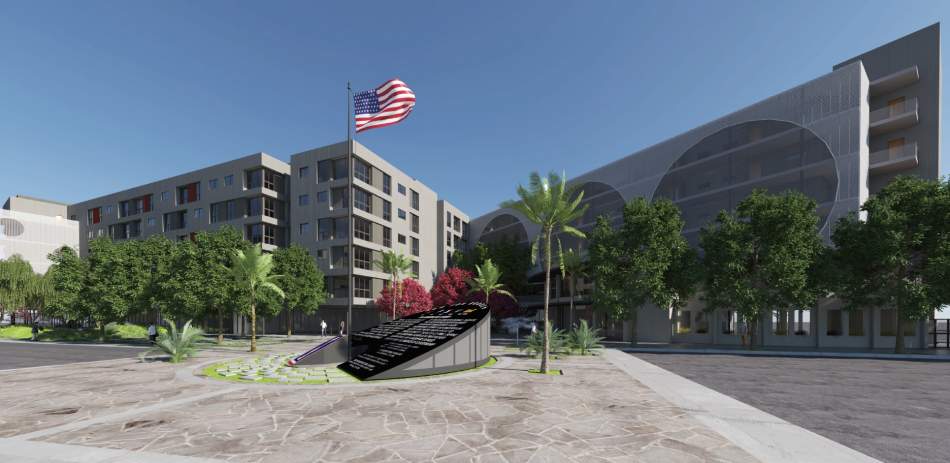 Rendering of the First Street North developmentCarde Ten
Rendering of the First Street North developmentCarde Ten
LTSC and Go For Broke are working with architecture firm Carde Ten on the project, which is depicted in a rendering as a contemporary six-story structure which would scale down in height adjacent to the Union Center for the Arts on Judge John Aiso Street.
Plans also goes beyond housing. Plans call for approximately 40,000 square feet of community-serving commercial space at the ground floor, as well as new offices for Go For Broke and an exhibition hall.
The active uses at street level would flank a new landscaped plaza and a pedestrian paseo recreating the footprint of Jackson Street, which was vacated in the mid 20th century. The new walkways and open space would offer a connection to both the Japanese American National Museum, MOCA, and the Go For Broke monument, which is currently situated in the midst of parking lots. Additionally, the paseo would line up with a similar passageway intended for a future development on the Parker Center site.
The expanded footprint of the LTSC and Go For Broke project has also opened up new discussions about the future of Lot 7 - another LADOT parking lot which will surrounding the new development to the north and west, and historic buildings lining 1st Street to the south. While no concrete plans have been set, the soon-to-be “landlocked” property will likely be less appealing to a for-profit developer going forward, says LTSC executive director Erich Nakano. That could allow the community to regain control of the property, potentially using it to serve neighboring businesses along 1st Street.
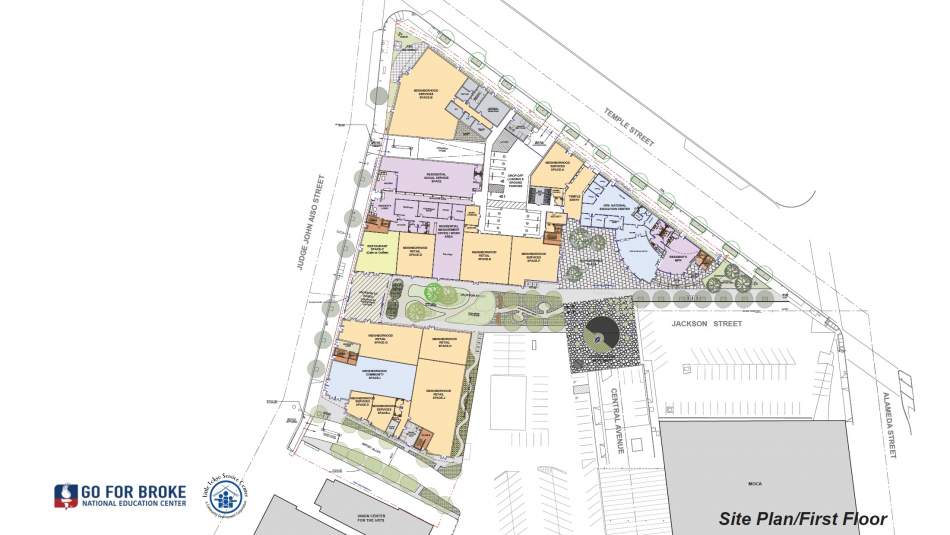 Site plan for the First Street North developmentLittle Tokyo Service Center
Site plan for the First Street North developmentLittle Tokyo Service Center
LTSC is exploring traditional affordable housing financing sources, according to Chen, including low income housing tax credits. Likewise, other traunches of funding such as new market tax credits could help pay for the community-serving retail planned at street level.
However, the timing of the project will depend on securing funding at the local level
"We're hoping to close a construction loan in early 2023 - but that's optimistic," said Chen.
While Go For Broke has eyed the property on Temple Street for more than 15 years, the proposed development was born out of the Sustainable Little Tokyo plan, which was developed by stakeholders and community members through the Little Tokyo Community Council (LTCC).
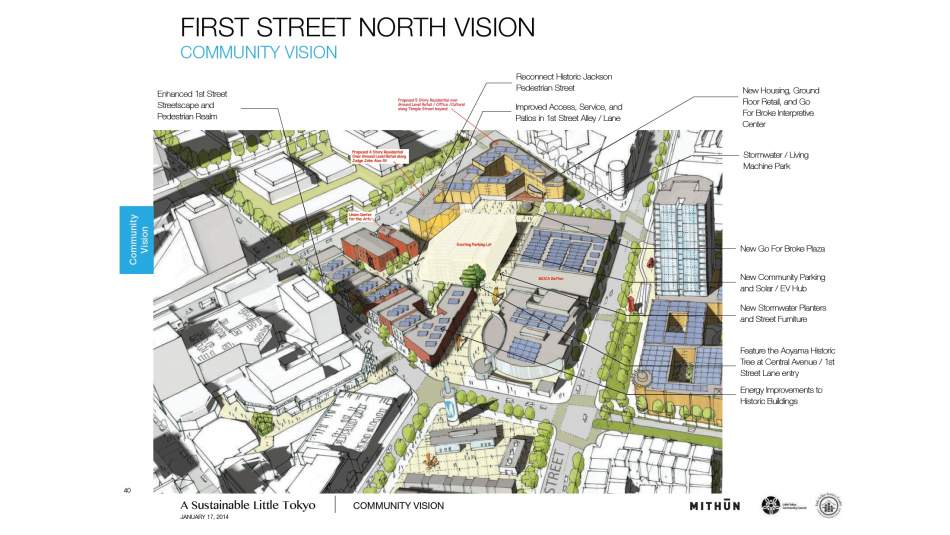 Concept designs from the Sustainable Little Tokyo PlanSustainable Little Tokyo
Concept designs from the Sustainable Little Tokyo PlanSustainable Little Tokyo
“It’s not the culmination, but the beginning of the end game for this planning process,” says Nakano. "To both reclaim this block and to plan out and envision what can be on the block. To enhance and strengthen the Little Tokyo neighborhood.”
The properties bounded by Temple and Judge John Aiso Streets, like the Parker Center site to the west, were once developed with homes and Japanese-American businesses. And like the Parker Center site to the west, individual lots later repurposed as parking were either acquired via eminent domain or through negotiations with property owners.
Following the completion of the Terasaki Budokan community center last year - the first time in recent memory that Little Tokyo's boundaries have expanded rather than shurnk, according to Chen - the First Street North project also represents a rare opportunity for the neighborhood to add new stores and restaurants, or even offer existing businesses a chance for expansion.
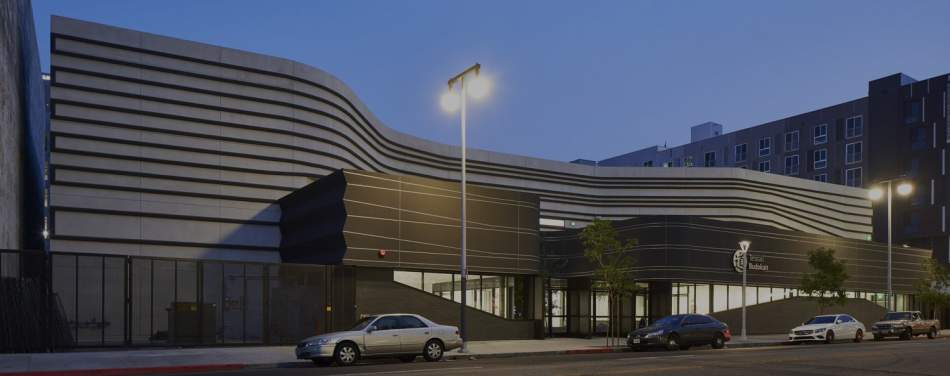 The Terasaki Budokan on Los Angeles StreetLittle Tokyo Service Center
The Terasaki Budokan on Los Angeles StreetLittle Tokyo Service Center
One hypothetical situation, says LTCC managing director Kristin Fukushima, would be for a neighborhood cornerstone such as the confectionary Fugetsudo to relocate its mochi-making operations to the First Street North site.
New momentum for the First Street North development also comes as Sustainable Little Tokyo, which was unveiled in 2013, finds itself in the midst of an update which will expand its focus to the entire neighborhood, according to Fukushima. In addition to setting an overall vision for the future of the neighborhood, the plan will also set out new goals for the First Street North, Mangrove, and Metro joint development properties, all of which have previously been targeted for redevelopment.
- 200 N Central Avenue (Urbanize LA)
Looking for affordable housing? Visit lahousing.lacity.org/aahr





